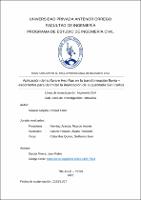Aplicación del software Hec-Ras en la transformación lluvia – escorrentía para delimitar la inundación de la quebrada San Carlos
Resumen
La presente tesis tiene como finalidad aplicar el software de modelamiento hidráulico Hec-Ras para modelar la transformación precipitación – escorrentía en la cuenca de la Quebrada San Carlos haciendo uso de sus nuevas herramientas presentes desde la versión 5.0 en adelante, convirtiendo al Hec-Ras en un software para la investigación.
Por lo general, para realizar este tipo de modelamientos se hace uso de un software de modelamiento hidrológico para agregar la data de precipitación, identificar la escorrentía superficial y sus respectivos hidrogramas e importarlos al software de modelamiento hidráulico. Con el uso de estas nuevas herramientas, se ingresará directamente al software Hec-Ras la data de precipitación, se programará el modelo y se hará llover sobre toda la cuenca, pudiéndose observar desde la precipitación, la formación de las corrientes de aguas superficiales, la dirección de flujo y todo el proceso de transformación lluvia – escorrentía de primera mano, con la finalidad de visualizar todo el proceso de manera detallada y mucho más precisa, obteniendo información útil y confiable para el manejo de recursos hídricos, la delimitación de la inundabilidad y la identificación de zonas de riesgo, demostrando la importancia del uso de estas herramientas computacionales para comprender y entender de manera más eficiente los procesos hidrológicos e hidráulicos The purpose of this thesis is to apply the Hec-Ras hydraulic modeling software to model the precipitation-runoff transformation in the Quebrada San Carlos watershed using its new tools introduced from version 5.0 onwards, turning Hec-Ras into a research-oriented software.
Generally, to carry out this type of modeling, a hydrological modeling software is used to input precipitation data, identify surface runoff and its respective hydrographs, and import them into the hydraulic modeling software. With the use of these new tools, precipitation data will be input directly into the Hec-Ras software, the model will be programmed, and rain will be simulated across the entire watershed. This allows for the observation of the entire process, from precipitation to the formation of surface water streams, flow direction, and the entire rain-runoff transformation process firsthand. The goal is to visualize the entire process in a detailed and more precise manner, obtaining useful and reliable information for water resources management, floodplain delineation, and identification of risk areas. This demonstrates the importance of using these computational tools to better understand and efficiently analyze hydrological and hydraulic processes
Palabras clave
Colecciones
- Ingeniería Civil [1302]


